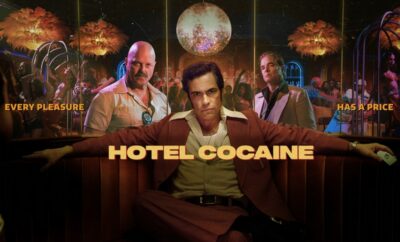Features
Shadowhunters: Book to Screen Comparison
By: Lindsay Flanagan
I’m a book nerd. As such, I feel it’s almost my duty to say when a book is adapted to a screenplay that “the book is always better.” Which, most of the time, the book is better. I can name one rare exception where the film is better and that is The Last of the Mohicans, but that’s another topic.
I don’t cling to my books so tightly that I can’t admit there are many screen adaptions I enjoy just as much as I do the original book. In fact, The Lord of the Rings is my favorite film series of all time. And although it didn’t always follow the books and even when it deviated from the book and added in new scenes or plot lines, I appreciated Peter Jackson’s interpretation of Tolkien’s world. I even loved The Hobbit and we all know that series strayed from the original novel’s plot lines in major ways. I love The Man in the High Castle. That novel is not a huge book or series so it doesn’t have nearly enough material to keep a long storyline going for a television show. Therefore, the writers came up with new plot lines in addition to switching up a few from the book. In that case, I’d say “The Man in the High Castle” series is inspired by the original novel.
So, where am I going with all of this? My point is that I usually go into television shows and films that have been based on books with an open mind and I’m rarely disappointed in the adaptions. Besides, “adapt” means “to change something so that it functions better or is better suited for a purpose.” That is was I expected with “Shadowhunters.” I read the series The Mortal Instruments by Cassandra Clare years ago so I will admit to being bit rusty on the details of the books. But I was prepared for the inevitable—even unavoidable—straying from the original story. I mean, along with the examples above, I have first-hand experience of adapting a novel to a screenplay (although not in any professional capacity) and it is hard! My senior capstone project in my undergrad was to adapt a novel to a screenplay. I had to change things to make them work. But what I tried to protect was the essence of the novel—something I think Peter Jackson did incredibly well with his interpretation of Middle-earth, and what the writers of “The Man in the High Castle” are doing. I don’t feel the same about “Shadowhunters.”
Every fan of the books is going to have differing opinions, but mine is that the show misses the mark. Cassandra Clare’s novels captivated me by her ability to take classical fantasy elements and update them for the modern age (which is, you know, a definition of urban fantasy – but I’m digressing). Clare’s writing made me want to jump into the pages and experience everything with Clary. I didn’t want to leap through my screen into the show. I felt like the whole production was a glamour (yes, I used that purposely) and it hid the true magic of Clare’s novels.
Here’s why: In the beginning of the book series, Clary Fray (played by Katherine McNamara in the show) is fifteen years old. The show starts out on her eighteenth birthday and this changes the entire feel of the story. In fiction, a novel with a protagonist who is fifteen years old is categorized as Young Adult. Age eighteen is right on the fence, but when the story focuses on the protagonist venturing out on his or her own for the first time and tries to find his or her place in the world, that moves it into the New Adult genre.
In the show, Clary is applying to college and getting ready to leave childhood behind. So, perhaps in that sense Clary being eighteen years old could have worked. She learns that her mother isn’t actually a normal human being (literally—she’s part angel) and that Jocelyn (Maxim Roy) has been covering up Clary’s true heritage. Then, Jocelyn gets kidnapped by the Circle, the bad guys who are led by the fallen Shadowhunter Valentine Morgenstern (played by Alan Van Sprang). Clary is left in the world on her own and it has completely changed because not only is she trying to figure out who she is going to be, she’s trying to figure out she has always been.
In trying to understand why the age was changed, I came across an interview Clare did for BNTeenBlog that explained the show’s reasoning. It didn’t have anything to do with Clary’s journey to find out who she was now that she was on her own. Clare stated that it was because the producers wanted to target an older audience, ages 18 to 35, and “a lot of elements meant to attract men were introduced—technology and computers—and there were a lot of scenes with ‘sexy’ women, a good portion of whom were bloodily murdered.” Clare did manage to step in and make changes to the pilot. Some of the scenes that showed murdered women were removed or changed. (If you want to know why Clare didn’t have control of the script—I mean, it’s her story, her world—read her interview. She explains about subsidiary rights of novels.)
Another issue with this changing of the target audience that doesn’t sit well is that when the film flopped (The Mortal Instruments 2013), the film company still owned the rights for optioning the film and TV. They felt that because the books were still enormously popular, they had missed an audience and thought they’d try to reach that audience with a television show. So, how is changing the target audience capturing the original audience? Why change it from Young Adult to New Adult? The only explanation (other than the one given above) was that they wanted to attract men to it. The first book, City of Bones, came out ten years ago. Was it because the original audience grew up? Maybe. But the entire audience didn’t suddenly turn male.
Not all men like computers and tech and there are plenty of women who do. I’m not a Hollywood exec, so I obviously don’t have any expert evidence like they do that computers and tech would draw in male viewers. Pulling in technology would be fine, if it was connected to the story and not just to draw viewers. Why do Shadowhunters need technology? Shadowhunters have the blood of angels in them, so they are otherworldy. Magic. And it is ancient power we’re talking about here, not new technology. So, the high tech business at the Institute (which in the books, is only inhabited by the Lightwoods, Jace and Hodge) detracts from the feeling of the Shadowhunter world as being old and even sacred. They use steles (ancient magic) and Sensors to fight demons. Sensors, I will admit, are fairly new. And, yes, they are a technological advancement for Shadowhunters. But if you’ve read the prequel series to The Mortal Instruments – The Infernal Devices, you’d know that Sensors were created by Henry Branwell during a time in history known as The Industrial Revolution. A better way—and reason—to bring in tech would be to explain who invented it and why it was needed. This present time is, in fact, a technological revolution. But an exploration into technological inventions probably doesn’t make for good television.
But there are still problems that make the show very different from the novels in the essence and spirit of the books. The character Lydia Branwell (Stephanie Bennett) was created to bring Idris to the Institute, but also to be an obstacle to the Alec Lightwood (Matthew Daddario) and Magnus Bane (Harry Shum, Jr.) relationship. The issue isn’t with the character Lydia—I don’t mind new characters as long as they have a purpose. Bringing Idris to the Institute encapsulates the idea of the rich Shadowhunter family history. But is this the female character the showrunners were referring to when they stated that Alec needed a female companion because “no one wanted to see a gay character onscreen with a man so a woman would be introduced for him to spend most of his time with?” She was described to Clare as Alec’s soulmate.
In the Shadowhunter world a soulmate is referred to as “parabatai,” something that is stronger than any other relationship that exists. It can be between two men, two women or one of each gender. And the basis isn’t romantic or sexual—it is all about being with your other half who protects your life as if it were their own. And it almost is because when your parabatai dies, you never find another and part of you is missing. It seems maybe parabatai wasn’t considered at all when they created Alec’s soulmate. And in case you’re wondering, Alec’s soulmate—parabatai—is Jace (played by Dominic Sherwood).
Clare noted that most of the original writers and producers from the first season have left and she feels better about the direction the show is going now. So, why am I all hot and bothered by it now? Because it’s hard to erase a first impression. The foundation of the show was built on was shaky, but hopefully the supporting walls that have been built will stable it out. I’ll try to keep an open mind as the series goes on. But I’ll probably abandon the show for Clare’s new book series The Dark Artifaces.





You must be logged in to post a comment Login